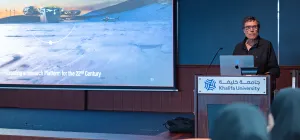A Productive Week Thanks to Great Weather

We are all settling in nicely to life at the station as we work hard to make sure everything is in order for the arrival of the first group of scientists in a few weeks’ time. We’ve been lucky to have gorgeous weather these last few weeks. It has allowed us to make a lot of progress.
Settling in
We are all settling in nicely to life at the station as we work hard to make sure everything is in order for the arrival of the first group of scientists in a few weeks’ time. We’ve been lucky to have gorgeous weather these last few weeks. It has allowed us to make a lot of progress.
Over the past week, we’ve been able to start up scientific instruments at the station and in the shelters nearby that collect data of all kinds of phenomena including cloud particle formation, UV radiation, and geomagnetic and seismic activity. Benoît Verdin has started the daily launch of weather balloons that collect weather data that contribute to regional weather forecasting and climate modelling, and not to mention the Year of Polar Prediction (YOPP).
We have also been doing regular maintenance checks on the station’s systems and making improvements whenever possible. We are making progress with the annual checkup of the station’s nine wind turbines, and performed maintenance on the station’s ventilation system, which has raised the humidity levels indoors to more comfortable levels. Antarctica is a cold desert with hardly any relative humidity. Sometimes the dryness can be uncomfortable.
Favourable weather conditions have made possible for PEA to produce excess energy, which is “dumped” into heating resistors in the annexes where the workshops and garages are located, making them nice and warm places for the mechanics to practice their trade. Although we have not needed them, we have also been doing general maintenance on the station’s backup generators (the gensets).
Preparing for the scientists’ arrival
In their warm and cozy garage the mechanics have been busy working on general maintenance of the skidoo fleet and vehicles leaving for Perseus Airfield 60 km north from the station.
We have been preparing living containers to support a six-person party who will spend ten days at Perseus Airfield to prepare the landing strip for the arrival of the Ilyushin-76 carrying the first team of scientists directly from Cape Town. The landing is scheduled on December 7th. The BELARE team built Perseus Airfield a few years ago to allow direct transcontinental flights, reducing the cost of transporting scientists and equipment from South Africa to PEA in a shorter amount of time.
Due to the constant flow of the ice sheet and accumulation of fresh snow, airfields in Antarctica need to be well maintained before planes can land on them. The party heading out to the airfield will make the runway perfect for welcoming the first teams of scientists!
Safe tracks have been prepared and mapped out leading to and from the station in all directions. This is a mandatory procedure to ensure that teams have a safe route to follow whether they are travelling close to the station or heading out into the field. But we are also mapping out tracks in our minds to prepare for the adventure that lies ahead for us this season.
Download





















